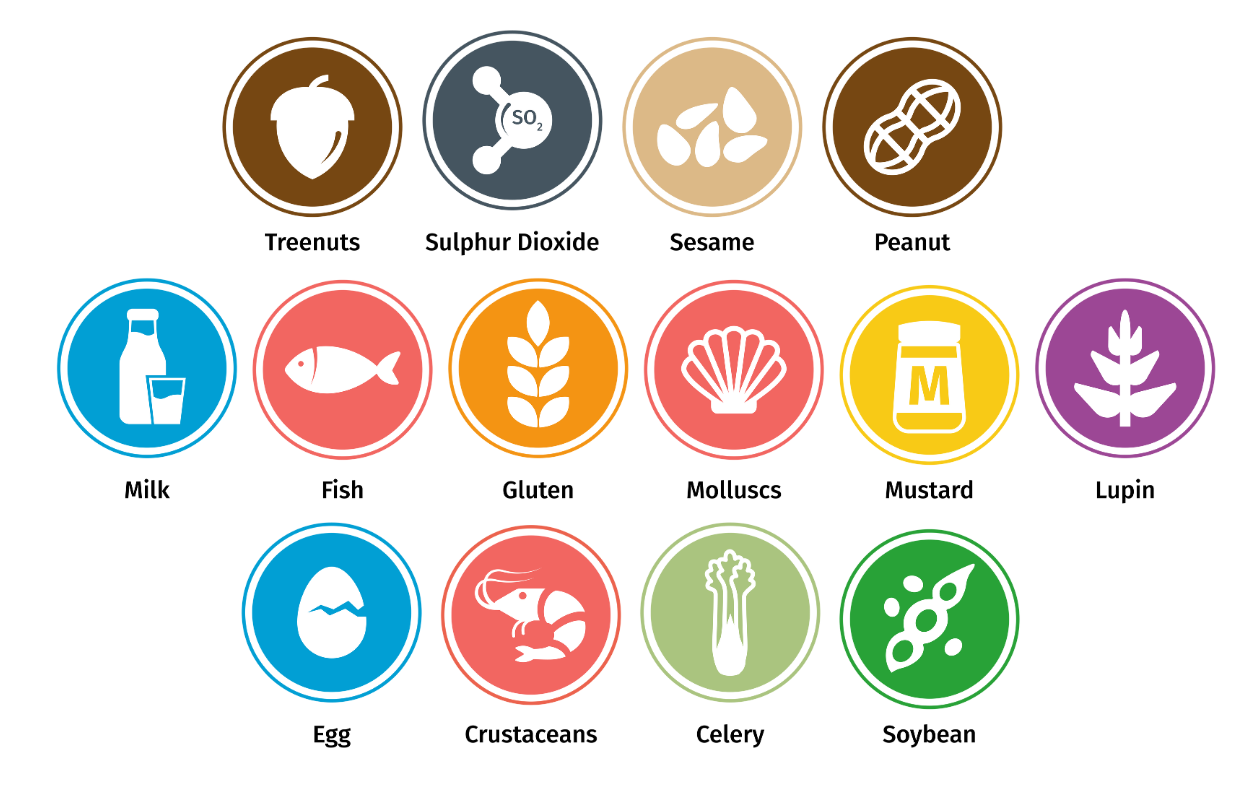Schools are required by law to provide clear information about specific allergens in all the foods and drinks they serve. Registered dietitian Juliette Kellow shares practical tips to assist catering teams, chefs and serving staff confidently manage food allergens from the kitchen through to the dining room.
Anyone involved in school food provision will be familiar with the legal requirement to provide clear and accurate allergen information so that students (and staff) with allergies can easily identify what’s safe to eat. While it’s possible to have an allergy or intolerance to almost any food or drink, the Food Information Regulations[1] require that 14 specific allergens are declared by law. These are…
- Celery
- Cereals containing gluten e.g. wheat, rye, barley, oats
- Crustaceans e.g. prawns, crab, lobster
- Eggs
- Fish
- Lupin
- Milk
- Molluscs e.g. mussels and oysters
- Mustard
- Peanuts
- Sesame seeds
- Soybeans
- Sulphur dioxide and sulphites – at levels above 10 parts per million
- Tree nuts e.g. almonds, hazelnuts, walnuts, cashews, pecans, Brazils, pistachios and macadamia

Here’s how to ensure allergen labelling is clear, accurate and appropriate for all foods and drinks served in educational settings…
- Ensure staff receive allergen training
It’s essential all staff in the school food chain – from menu planning to service – receive thorough training to manage allergens effectively. This includes caterers who develop recipes and menus, chefs and kitchen staff who prepare food, and serving staff who interact directly with students. Everyone should understand what allergens are, which allergens require labelling by law, and the importance of providing accurate information. Training should also cover the risks of cross contamination during preparation, food storage and service, and how to prevent it. The Food Standards Agency[2] provides free online food allergy training, and several resources to assist catering teams.
- Understand how packaging affects allergen information provision
While all foods and drinks served in schools are legally required to provide allergen information, the presentation of this information varies according to how products are packaged[3]. It’s essential catering staff understand these rules so they can confidently comply with these legal requirements. As a guideline…
- Prepacked – products packaged by an external manufacturer and sold in their original packaging – such as pots of yogurt, individual packets of savoury snacks or dried fruits, milk or juice cartons, or cereal or snack bars – must display the name of the food and a full ingredients list that highlights any of the 14 allergens. Find more information here.
- Prepacked for direct sale (PPDS) – following the introduction of Natasha’s Law on 1 October 2021[4], items that are prepared and packaged on the same site or premises before being offered or sold to students – such as sandwiches, wraps, salad pots or boxes, or baked goods – must show the name of the food, full ingredients list, and highlight any of the 14 allergens within the ingredients. Find more information here.
- Non prepacked – unpackaged foods served directly to students e.g. meals like chillies, curries, stir fries, lasagne and salads, accompaniments like jacket potatoes, chips, pasta, bread rolls, and vegetable dishes, and other items like fruit or bread rolls, don’t need a full ingredients list but must have allergen information available. This can be given verbally by serving staff, but it’s best to support this with written information, e.g. on a menu, chalkboard or label, to ensure it is accurate. The Food Standards Agency has developed a set of allergen icons that food businesses can download and use on menus. Find more information here.
- Maintain clear communication channels with suppliers
Suppliers must provide allergen information for all products, enabling caterers to review ingredients and label dishes correctly. It’s also vital to have protocols in place that allow suppliers to promptly alert caterers of any changes to the ingredients or allergens in products that are regularly ordered – or sent as substitutions – so that allergen information can be updated to reflect this.
- Communicate changes effectively to staff
It’s equally important to establish procedures to ensure any updates or changes to allergen information are communicated to all relevant staff including menu planners, chefs and serving staff. Changes may result from…
- Product reformulation that results in a change in ingredients
- Products being substituted due to supply issues
- Chefs modifying recipes and/or introducing new ingredients
- Last minute menu changes
See the Food Standards Agency Allergen Checklist.
- Consider allergens when recipe and menu planning
Allergens are often only thought about after recipes and menus have been developed, usually to meet legal compliance. However, considering allergens at the outset can help to ensure menus offer a wide range of tasty dishes suitable for all students, including those with allergies. Key points to consider:
- Don’t assume vegan means allergen-free: vegan meals may still pose risks due to potential cross-contamination with animal-based allergens like fish, crustaceans, molluscs, milk or egg.
- Be aware of substitutions: removing one allergen may introduce another. For example, swapping cow’s milk for soya milk eliminates milk but introduces soybeans; swapping egg for tuna in a salad eliminates eggs but adds fish; or substituting plain flour for almond flour removes gluten but adds nuts.
- Make allergen-free ingredients the norm: consider using allergen-free products as the standard for frequently used ingredients, e.g. gluten-free gravy granules, stocks, sauce and soup mixes, and custard powders. However, ensure other added ingredients don’t reintroduce allergens e.g. adding gluten-containing soy sauce to a dish that uses gluten-free stock.
- Look for products that minimise allergen content: products that are free from – or limit – the 14 allergens can help to simplify menu planning and reduce the risk of allergen exposure.
- Use an allergen matrix: this is a tool that lists all menu items against the 14 allergens. It provides an at-a-glance guide to all the allergens in dishes and highlights areas where menus are performing well or are lacking in allergen-friendly choices. Find more information here.
- Prevent allergen cross contamination
It’s vital to prevent allergen cross-contamination when food is stored, prepared or served. The following best practices can help to minimise risks…
- Clean workstations, equipment and utensils thoroughly before and after preparing allergen-free meals.
- Wash hands between handling different foods to prevent allergen transfer.
- If space permits, allocate specific kitchen areas for preparing allergen-free dishes.
- Use separate utensils, cutting boards and cookware for allergen-free preparation. If this isn’t feasible, ensure all equipment is thoroughly cleaned between uses.
- Use fresh oil and dedicated fryers for allergen-free dishes – oil that’s previously been used to cook battered or breaded ingredients or fish, is unsuitable for cooking gluten-free or fish-free dishes.
- Don’t remove food labels that include the product name and ingredients.
- Store ingredients and prepared dishes with and without allergens in covered and labelled containers, ideally in separate areas of the kitchen.
- When serving food, keep allergen-free dishes apart and use separate utensils – for example, use different spoons for serving pasta (which contains gluten) and rice (which has no gluten).
- Ensure trays and tables in dining areas are thoroughly cleaned to prevent the transfer of allergens.
The Food Standards Agency advises: If you can’t avoid cross-contamination in food preparation, you should inform customers you can’t provide an allergen-free dish.2
Meanwhile, don’t automatically label dishes as being ‘free-from’ specific allergens. According to the Food and Drink Federation this term should only be used following a rigorous assessment of the ingredients, process and environment. Find more information here.
- Keep comprehensive allergen records
While an allergen matrix (see above) provides a quick reference for identifying allergens in different menu items, it’s also important to keep comprehensive written records for each dish. Begin by documenting recipes and including detailed ingredients lists for each. This should include recording the individual ingredients in composite products such as ready-made sauces, stocks, gravy powders, and marinated meat, as these may contain allergens. This information can be sourced from product specification sheets and ingredient labels provided by suppliers. From this, a complete list of allergens for each dish can be recorded. It’s vital to regularly update these records to reflect any changes in recipes or ingredients (including composite products) to ensure that allergen information remains accurate and up-to-date.
- Implement systems to identify students with allergen-free needs
It’s essential that serving staff can quickly and accurately identify students who need to avoid specific allergens. The Food Standards Agency suggests practises such as photos of children alongside details of their allergy in the kitchen or serving area[5]. The key is to find a system that works for staff and students, promotes inclusivity and prevents stigmatisation[6], and complies with data protection regulations.
By putting these practices in place, school catering teams, chefs and serving staff can help to keep students with food allergies safe, whilst also meeting legal requirements for food allergen information with confidence.
Authors Bio

Juliette Kellow is a highly experienced nutrition consultant with over 20 years of expertise working with food-focused clients. Originally from Cornwall, she holds a first-class BSc Honours Degree in Dietetics from Leeds Polytechnic (now Leeds Beckett University).
Her career spans roles as an NHS dietitian, food industry nutritionist, and editor of Top Santé magazine. Juliette has collaborated with the food industry on reformulation, NPD, fortification, nutrition legislation, and professional presentations.
As a published co-author of books such as Eat Better Live Longer and Simply Nutrition (DK Books) and with hundreds of articles to her name, Juliette specialises in making nutrition accessible. A member of the British Dietetic Association and registered with the HCPC, her work is both credible and evidence-based.
References
[1] Legislation.gov.uk. Statutory Instruments 2014 No. 1855. The Food Information Regulations 2014.
[2] Food Standards Agency. Allergen guidance for food businesses. Updated 14 March 2025.
[3] Food Standards Agency. Food allergen labelling and information requirements technical guidance: Summary. Updated 6 Mach 2025.
[4] Natasha Allergy Research Foundation. Natasha’s Law.
[5] Food Standards Agency. Allergen guidance for institutional caterers. Updated 14 December 2017.
[6] Allergy UK. For Schools.











